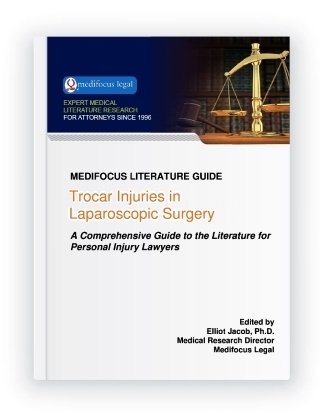Trocar Injuries in Laparoscopic SurgeryA Comprehensive Guide to the Literature for Personal Injury Lawyers
Publisher: Medifocus Legal
Publication Date: March 21, 2018
Number of Pages: 166
A Comprehensive Guide to the Literature for Personal Injury Lawyers
Publisher: Medifocus LegalPublication Date: March 21, 2018
Number of Pages: 166
Although the overall rate of adverse events associated with laparoscopic surgery is low (1%), studies have shown that about 50% of all complications occur during initial trocar insertion for access to the peritoneal cavity. In general, trocar injuries occur when internal organs are unusually close to the point of trocar insertion or where the trocar penetrates too far into the abdominal cavity as it is inserted. The most feared and potentially devastating complications of direct trocar insertion for initial laparoscopic access are vascular injuries to the aorta and blood vessels and penetrating injuries of the large and small bowel. Such injuries are frequently catastrophic and are associated with high morbidity and mortality.
Irrespective of the specific type of laparoscopic procedure, trocar-related injuries are a leading cause of medical malpractice litigation as most of these complications happen at the time of initial laparoscopic access. Although the risk of vascular and bowel injuries are well recognized complications of laparoscopic trocar insertion, most medical malpractice claims arising from such injuries are based on the failure of the surgeon to recognize and repair the injury either intraoperatively or during the early postoperative period. Other factors that may provoke litigation in trocar-related injuries include failure to obtain proper informed consent, failure to disclose the risks of the procedure, and deviations from proper surgical technique.
The MediFocus Literature Guide to Trocar-Related Injuries is a comprehensive Guide to the medical literature for personal injury attorneys who may represent clients who have sustained a trocar-related injury while undergoing a laparoscopic procedure. This unique Literature Guide includes 184 hand-selected references to articles published in peer-reviewed journals with links to the abstracts and FREE online access to the full-text version of 18 articles. The Guide promises to be a valuable addition to the library of any personal injury attorney or law firm involved in litigating laparoscopic trocar entry injuries.
 |
- A comprehensive bibliography of 184 journal article references indexed in MEDLINE published in well respected medical and scientific journals.
- Online access to the abstracts (summaries) of the articles.
- Online access to the free full-text version of 18 articles.
- Links to full-text sources of other articles that are available for purchase directly from individual journal publishers.
- A unique "Author Directory" consisting of the names and institutional affiliations of experts who have published and have specialized knowledge about Trocar Injuries in Laparoscopic Surgery. The "Author Directory" is a valuable resource for quickly identifying and locating experts for case reviews, opinions, and testimony.
Select examples of topics that are covered by the articles referenced in this Guidebook include:
- Direct Laparoscopic Trocar Insertion: Lessons Learned from Nine Litigated Cases.
- Trocar Injuries in Laparoscopy: Techniques, Tools, and Means for Prevention.
- Trocar in conventional laparoscopic and robotic-assisted surgery as a major cause of iatrogenic trauma to the patient.
- The safety of direct trocar versus Veress needle for laparoscopic entry: a meta-analysis of randomized clinical trials.
- Avoiding major vessel injury during laparoscopic instrument insertion.
- Recognition and management of major vessel injury during laparoscopy.
- Three simple steps during closed laparoscopic entry may minimize major injuries.
- Major complications during laparoscopic cholecystectomy
- Recognition and prevention of gastric injury during gynecologic laparoscopy.
- Trocar-associated injuries and fatalities: an analysis of 1399 reports to the FDA.
- Bowel injury as a complication of laparoscopy.
- Laparoscopic bowel injuries: forty litigated gynaecological cases in Canada.
- Direct visual or blind insertion of the primary trocar.
- Survey of laparoscopic entry injuries provoking litigation. J Am Assoc Gynecol Laparosc. 2001 Aug;8(3):341-7.
- Trocar and Veress needle injuries during laparoscopy.
- Delayed recognition of inadvertent gut injury during laparoscopy.
- Complications of laparoscopy. Strategies for prevention and cure.
- Delayed recognition of major vascular injury during laparoscopy.
- Malpractice litigation involving laparoscopic cholecystectomy. Cost, cause, and consequences.
- Pneumoperitoneum needle and trocar injuries in laparoscopy. A survey on possible contributing factors and prevention.
is available in two formats: | |
Order by Phone:To order by phone, please call: Order by Mail:To order by mail, please print and complete this Order Form | |

